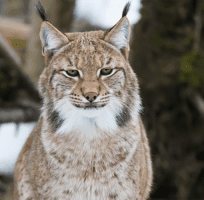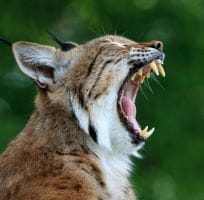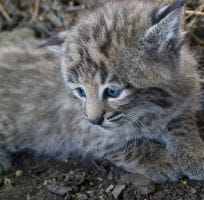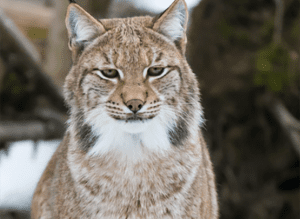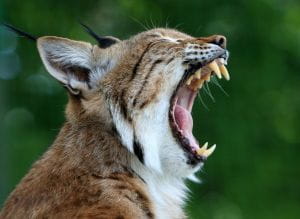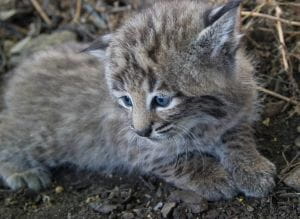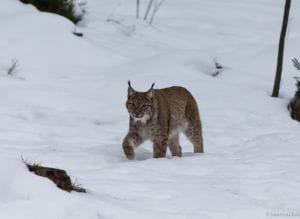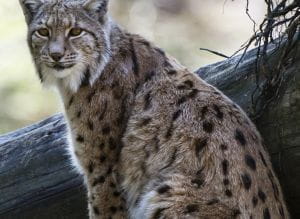A very, very extensive range
The boreal lynx is Europe’s largest feline, originally spread from the Pyrenees to the Far East; the most extensive distribution of any cat on Earth. However, from the 16th century onwards, its population declined, and it disappeared from Western Europe between the 17th and 20th centuries, from France probably in the 18th century.
Today, the boreal feline is one of the largest felines in Europe.
Today, the European population is estimated at 9,500 individuals, mainly distributed around the Baltic Sea and in the Carpathians. In Russia, the species is not considered endangered.
The situation in Western Europe is quite different. In France, for example, its population is estimated at less than 200 adults. As such, it remains very fragile in the face of numerous human pressures (road collisions and poaching), and as such the lynx is on the red list of threatened species.
And an unexpected return to the French Jura
The Northern Lynx reappeared in the Jura in the 1970s, coming from Switzerland where it had been reintroduced by Swiss naturalists. Its range gradually expanded, reaching the Ain département in the mid-80s. To reinforce this colonization, around twenty individuals were introduced into the Vosges in 1983. There does not yet appear to be any exchange between the two populations.
In 2007, sightings of a male and then a followed female in the Alpes-Maritimes, between Mons, Fayence and Thorenc, were among the most southerly in the Alpine arc. And there are still many mysteries surrounding the feline’s vacationing grounds and movements as it settles in.
A discreet and solitary forester
This big, short-tailed wildcat has pointed ears ending in a tuft of black hair. It has just 28 teeth instead of the usual 30 for felines. In proportion to their bodies, their paws are much larger than those of cats, enabling them to walk in the snow without sinking, like snowshoes. Its dense fur ranges from creamy white to dark brown, with varying degrees of black spotting.
Its measurements vary enormously.
Its measurements vary enormously depending on the environment: 70 cm high, 120 cm long (including tail) and weighing between 9 and 35 kg. In France, its average weight is between 20 and 25 kg maximum.
The lynx is a territorial animal that lives solitary year-round on a territory ranging from 90 km2 for a female to 250 km2 for a male.
The male’s territory often overlaps that of several females. Carefully demarcated by markingsjugal (cheek rubbing on tree stumps) or ano-genital (urine spraying on tree trunks or rocks), this home range is used for hunting and rearing young.
A discreet animal, it only leaves its territory when it is ready.
A discreet animal, it only exceptionally leaves the low- and medium-altitude forests it favors.
It is reluctant to venture out into the open over long distances and moves through wooded corridors, regularly using forest tracks or paths. It readily seeks out rocky bars that offer shelter or dens. Provided its favorite prey is abundant.
Deer, the lynx’s preferred prey
The Boreal lynx is a strict carnivore. It only eats meat it has hunted itself. Some consumption of carrion has been observed, but so rarely that this practice is considered negligible.
The feline has its prey of choice, the deer, like the cat with the mouse. It’s hardly surprising, then, that its return has accompanied the spectacular increase in this ungulate’s numbers in eastern France.
The lynx eats between 1 and 3 kg of meat per day. This represents around 60 ungulates per year (roe deer 70%, chamois 20%, other prey 10% including fox, hare, marmot or mustelids and more rarely birds.)
This is a hunter on the prowl who pounces at very close range on his prey and kills it, after mowing it down with his foreleg, with a bite to the throat or neck. Thigh muscles and liver are eaten first (three observations on the Reserve). This makes the difference with the wolf, which first opens the rib cage (six observations on the Reserve).
For the French association FERUS, a specialist in large carnivores, roe deer and chamois account for up to 90% of the lynx’s prey. Once it has killed a large animal, it may return to consume it several days in a row, always starting with the fleshiest parts (thighs, then shoulders). The skin is then progressively pulled back towards the head to reveal the muscles.
Brief weddings or darling hurt me…
Males and females only get together during the mating season. The rut begins in late February and ends in April.
When females are in heat, they deposit their urine mainly on tree trunks. In this urine, numerous pheromones inform the male in the territory of the females’ ovulation period.
The mating season begins in late February and ends in April.
The night then resounds with short, powerful feints, “WAaaou”, uttered by the male (two listenings on the Reserve in 2009 and 2010). Mating is brief, lasting just a few days. Mating remains lively and agitated, and from these embraces, the female often retains bites on her spine.
After 10 weeks’ gestation, she gives birth and will raise two to three young on her own, returning to her den after nocturnal hunts in the early weeks. Thereafter, she will regularly change refuge. It’s easier for her to move her young than to transport a killed prey. Despite all these precautions, kittens have a 50% mortality rate in their first year!
High-risk emancipation
The emancipation of the young is sudden, from January to April, when the next breeding season arrives. The female then pushes them to leave her territory despite their young age (10 months).
The most critical period in a lynx’s life. Still inexperienced in hunting, they must learn to survive in unfamiliar places and face multiple dangers. Mortalities are frequent on roads and railroads. It also happens that these undernourished and weakened carnivores are collected near dwellings, as in the Jura on several occasions.
See the remarkable work of Centre ATHENAS – 39 570 L’Etoile – 03 84 21 66 05
Feline presence in Thorenc
The presence of lynx in the valley has been confirmed since 2006. However, direct observations are very rare (one female and one youngster in 2007 – one adult male in 2023).
A few roe deer corpses or the calls of a male under rocky bars nevertheless confirm its presence, even if temporary.
